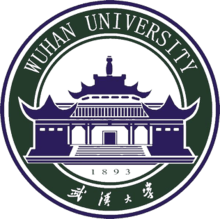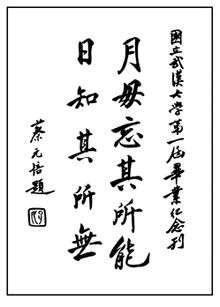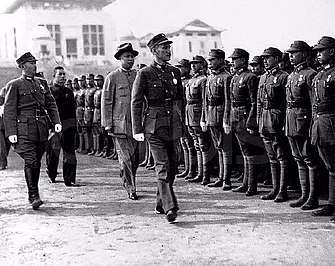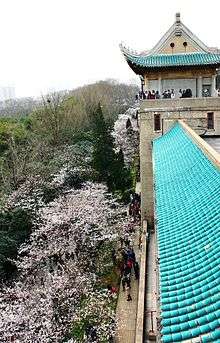Wuhan University
|
武汉大学 | |
 | |
| Motto | 自强 弘毅 求是 拓新 (in Chinese)[1] |
|---|---|
Motto in English | Self-improvement, Perseverance, Truth-seeking, Innovation[2] |
| Type | National research university |
| Established | November 29, 1893 |
| President | Dou Xiankang |
Academic staff | 5,000 |
| Students | 53,000 |
| Location | Wuhan, Hubei, China |
| Campus | Urban, 5,600 mu (亩) |
| Website |
www |
 | |
Wuhan University (WHU; simplified Chinese: 武汉大学; traditional Chinese: 武漢大學; pinyin: Wǔhàn Dàxué; colloquially 武大, Pinyin: Wǔdà) is in Wuhan, Hubei, China.[3] It is a Chinese Ministry of Education Class A Double First Class University.[4] The university is at Luojia Hill, with palatial buildings blending Chinese and Western styles. It was commonly regarded as one of the most beautiful campuses and a top 10 university for decades in China.[5] It is administered by the Ministry of Education of China. It was selected by both Project 985 and Project 211 as a major receiver of state funding.
History


The university dates back to the Ziqiang Institute (simplified Chinese: 自强学堂; traditional Chinese: 自強學堂; Pinyin: Zìqiáng Xuétáng), which was founded in 1893 by Zhang Zhidong 张之洞, governor of Hubei and Hunan Provinces in the late Qing Dynasty.[6]
It changed its name several times before it was named National Wuhan University in July 1928 and was among the first group of national universities in modern China. (There is a dispute on the establishment of Wuhan University: Some believe that its history should date back to 1913, when the National Wuchang Higher Normal College was founded.)
In the early time of its establishment, Ziqiang Institute provided four courses: Chinese, Mathematics, Nature, and Business. After combining the Institute of Minerals and the Institute of Chemical, courses provided were enlarged, with Nature Science and Engineering added. Chinese was extended to English, French, German, Russian, and Japanese.
In October 1902, Ziqiang Institute moved to Dongchang kou, Wuchang, and changed its name to Foreign Languages Institute (simplified Chinese: 方言学堂), teaching Geography, History, Mathematics, Law, and Communication.
With the approaching of the Revolution of 1911 (simplified Chinese: 辛亥革命), the Foreign Languages Institute was forced to pause due to lack of funding. In October, the Wuchang Uprising (simplified Chinese: 武昌起义) and the end of the Qing dynasty made it impossible for the school to go back to normal. The Foreign Languages Institute stopped running.
In 1913, the Ministry of Education of Beiyang Government (simplified Chinese: 北洋政府) decided to found six higher normal colleges in China. Based on the original location, book resource, and faculties of Foreign Language Institute, the Wuchang State Superior Normal Institute (simplified Chinese: 国立武昌高等师范学院) was founded.
In 1922, faculties were extended to Education Philosophy, Chinese, English, Mathematics, Physics and Chemical, History and Sociology, Biology, and Geography.
In August 1923, the school changed its name to the Wuchang State Normal University (国立武昌师范大学). In 1924, it changed its name to Wuchang State University (国立武昌大学).
In 1926, Wuchang State University merged with the Wuchang State Business University (Simplified Chinese: 国立武昌商科大学), Hubei University of Medicine (湖北省立医科大学), Hubei University of Law (湖北省立法科大学), Hubei Arts and Humanity University (湖北省立文科大学), Wuchang Private Chinese University (私立武昌中华大学) to form Wuchang Sun Yat-Sen State University (国立武昌中山大学), alias No. 2 Sun Yat-Sen State University (国立第二中山大学), with Department of University, and subjects of Arts, Science, Law, Business, Medicine and Yu (文, 理, 法, 经, 医, 预), 17 faculties, 2 departments.
In 1928, Nanjing National Government (南京国民政府) formed Wuhan State University (国立武汉大学) on the basis of the original National Wuchang Sun Yat-Sen University, consisting of four colleges: Arts, Law, Science, and Engineering (文, 法, 理, 工).

In February 1929, the jurist Wang Shijie became the first president of Wuhan University. During the War of Resistance Against Japan, Wuhan University moved to Leshan, Sichuan Province and returned to Luojia Hill after the war.[7][8]
By the end of 1946, the university had six faculties: liberal arts, law, sciences, engineering, agriculture and medicine. Wuhan University enjoyed a very high academic status, with Wang Shijie, Wang Xinggong, and Zhou Gengsheng as its successive presidents.[8]
Scholars such as Gu Hongming, Zhu Kezhen, Wu Baoliang, Zha Qian, Gui Zhiting, Ye Yage, Li Siguang, Wen Yiduo, Huang Kan, Yu Dafu, Shen Congwen, Zhu Guangqian, Liu Ze, Liu Yongji, Ye Shengtao, Yang Duanliu, and Li Jiannong taught here successively. According to the university, in 1948, the University of Oxford wrote an official letter to the Ministry of Education of the Chinese National Government, stating that Bachelors of liberal arts and sciences that graduated from Wuhan University with average grades above 80 could enjoy "the senior status of Oxford".[8][9]

In 1952, after a general reshuffle of the colleges and departments of the higher education institutions throughout the country, Wuhan University became a university of liberal arts and sciences directly under the administration of the Ministry of Higher Education.[10] Professor Li Da, delegate to the First Congress of the Chinese Communist Party and a celebrated philosopher, economist and academician of the Chinese Academy of Sciences, held the post of president of the university for 14 years. The Wuhan University School of Medicine and Tongji University Medical School jointly formed Central-south Tongji Medical College (later Wuhan Medical College), then Tongji Medical University.[8]
Merger
On August 2, 2000, with the approval of the State Council of the People's Republic of China, the new Wuhan University was established as a combination of four major universities close together: the former Wuhan University, the former Wuhan University of Hydraulic and Electrical Engineering (WUHEE), the former Wuhan Technical University of Surveying and Mapping (WTUSM), and the former Hubei Medical University (HBMU).[11]
Note:
- Wuhan University of Hydraulic and Electrical Engineering (WUHEE) (Simplified Chinese: 武汉水利电力大学; Traditional Chinese: 武漢水利電力大學; Pinyin: Wǔhàn Shuǐlì Diànlì Dàxué; colloquially 武水, Pinyin: Wǔshuǐ).
- Wuhan Technical University of Surveying and Mapping (WTUSM) (Simplified Chinese: 武汉测绘科技大学; Traditional Chinese: 武漢測繪科技大學; Pinyin: Wǔhàn Cèhuì Kējì Dàxué; colloquially 武测, Pinyin: Wǔcè).
- Hubei Medical University (HBMU) (Simplified Chinese: 湖北医科大学; Traditional Chinese: 湖北醫科大學; Pinyin: Húběi Yīkē Dàxué; colloquially 湖医, Pinyin: Húyī).
Historical names
| Year | School name in English |
School name in simplified Chinese |
School name in traditional Chinese |
School name in Pinyin |
|---|---|---|---|---|
| 1893 | Ziqiang Institute | 自强学堂 | 自強學堂 | Zìqiáng Xuétáng |
| 1902 | Foreign Languages Institute | 方言学堂 | 方言學堂 | Fāngyán Xuétáng |
| 1913 | National Wuchang Superior Normal College | 国立武昌高等师范学校 | 國立武昌高等師範學校 | Guólì Wǔchāng Gāoděng Shīfàn Xuéxiào |
| 1923 | National Wuchang Normal University | 国立武昌师范大学 | 國立武昌師範大學 | Guólì Wǔchāng Shīfàn Dàxué |
| 1924 | National Wuchang University | 国立武昌大学 | 國立武昌大學 | Guólì Wǔchāng Dàxué |
| 1926 | National Wuchang Zhongshan University | 国立武昌中山大学 | 國立武昌中山大學 | Guólì Wǔchāng Zhōngshān Dàxué |
| 1928 | National Wuhan University | 国立武汉大学 | 國立武漢大學 | Guólì Wǔhàn Dàxué |
| 1949 | (Original) Wuhan University | (老) 武汉大学 | (老) 武漢大學 | (lǎo) Wǔhàn Dàxué |
| 2000 | (New) Wuhan University | (新) 武汉大学 | (新) 武漢大學 | (xīn) Wǔhàn Dàxué |
Academics
In 2014, Wuhan University's student body consisted of 34,131 full-time undergraduates and 13,918 full-time master's degree candidates, 7,477 Ph.D candidates and 1,477 international students.[12]
Rankings
China
Wuhan University is ranked among the top 10 universities in China.
In 2016, CUAA ranked it the 4th.[13]
In 2015, CUAA ranked it the 4th[14] and Wu Shulian ranked it the 7th.[15]
In 2014, CUAA ranked it the 5th[16] and Wu Shulian ranked it the 7th.[17]
World
In 2016, US News and World Report ranked it 251st in the world and 9th in China.[18]
In 2015, QS World University Rankings ranked it 273th in the world and 9th regionally.[19]
In 2015, Academic Ranking of World Universities ranked it between 301st-400th in the world[20] and 14th-27th in Greater China (including Mainland China, Hong Kong, Macau and Taiwan).[21]
It came 351st-400th in the 2014 Times Higher Education World University Rankings where it ranked 10th in China.[22]
Schools and colleges
- School of Philosophy (哲学学院)
- School of Chinese Classics (国学院)
- College of Chinese Language and Literature (文学院)
- School of Foreign Languages and Literature (外国语言文学学院)
- School of Journalism and Communication (新闻与传播学院)
- School of Art (艺术学院)
- School of History (历史学院)
- School of Economics and Management (经济与管理学院)
- School of Law (法学院)
- School of Marxism (马克思主义学院)
- Department of Sociology (社会学系)
- School of Political Science and Public Management (政治与公共管理学院)
- College of Education (教育科学研究院)
- School of Information Management (信息管理学院)
- School of International Education (国际教育学院)
- School of Mathematics and Statistics (数学与统计学院)
- School of Physics and Technology (物理科学与技术学院)
- College of Chemistry and Molecular Sciences (化学与分子科学学院)
- College of Life Science (生命科学学院)]
- School of Resource and Environmental Sciences (资源与环境科学学院)
- Institute for Advanced Studies (IAS) (高等研究院)
- School of Power and Mechanical Engineering (动力与机械学院)
- School of Electrical Engineering (电气工程学院)
- School of Urban Design (城市设计学院)
- School of Civil Engineering (土木建筑工程学院)
- School of Water Resources and Hydropower Engineering (水利水电学院)
- Electronic Information School (电子信息学院)
- School of Computer Science (计算机学院)
- International School of Software (国际软件学院)
- School of Geodesy and Geomatics (测绘学院)
- School of Remote Sensing and Information Engineering (遥感信息工程学院)
- School of Printing and Packaging (印刷与包装系)
- School of Medicine (医学院机关)
- Medical Research Institute (医学研究院)
- School of Basic Medicine Sciences (基础医学院)
- School of Health Sciences (健康学院)
- Renmin Hospital of Wuhan University, Hubei General Hospital (第一临床学院)
- Zhongnan Hospital (第二临床学院)
- School of Stomatology (口腔医学院)
- School of Pharmaceutical Sciences (药学院)
- Medicine Vocational and Technical School (医学职业技术学院)
Campus


The university has rolling physical features with the scenic Luojia Hill and the beautiful East Lake. Its campus is heavily wooded and green, with fragrant flowers everywhere year-round. Wuhan University is widely known as one of the most beautiful universities in China, especially for its cherry blossom garden. A cherry blossom festival is held every spring.[23]
Most stylish old buildings were designed by F. H. Kales (1899–1979).[24] Educated in MIT, Kales was a pioneer to blend western architectural styles with traditional Chinese elements, which is most evident from his roof designs.
Wuhan University boasts a campus covering an area of 5508 mu and has a floor area of 2.42 square kilometres. The university's libraries have a collection of approximately 5.4 million volumes and subscriptions to more than 10,000 Chinese and foreign periodicals.[25]
- Luojia Hill (Luojiashan)
- Former School of Science
- Administration Building, Former School of Engineering
- Former Dorm for male students
- Wuhan's blue roof tiles
- 2nd Classroom Building
- 3rd Classroom Building
- Former Law School Building
- Student Club
- Student Union and Debate Team
Cooperation
Wuhan University has established cooperative relationship with more than 300 universities and research institutes in over 40 countries and regions.
- School of Information Management at Wuhan University signed a cooperation agreement with Royal School of Library and Information Science in Denmark in 2009.[26][27]
- Wuhan University has collaborated with Duke University and the city of Kunshan to establish Duke Kunshan University.[28][29]
Art and culture
- Luojia Golden Fall Art Festival
- Luojia Golden Fall International Cultural Festival
- Students' Associations Cultural Festival
- Campus Supermarket of Cultural Activities
Notable alumni
- Guo Moruo, Chinese author, poet, historian, archaeologist, and government official from Sichuan, China
- Chen Tanqiu, Chinese revolutionary, founding member of the Communist Party of China
- Shen Congwen, Chinese writer
- Wen Yiduo, Chinese poet and scholar
- Li Long Lam, Hong Kong Archaeologist
- Li Siguang, the founder of China's geomechanics
- Ling Shuhua, Chinese modernist writer whose short stories became popular during the 1920s and 30s
- Wan Exiang, professor of international law at Wuhan University, vice president of the Supreme People's Court of China, and vice president of the Revolutionary Committee of the Kuomintang
- Su Xuelin, Chinese author and scholar
- Xiaokai Yang, Chinese-Australian economist.
- Wang Tieya, an eminent Chinese jurist and former judge of the International Criminal Tribunal for the Former Yugoslavia
- Li Haopei, Chinese jurist, diplomat and academic
- Chao Yao-dong, Taiwanese politician, economist and former Minister of Economic Affairs (1981–84)
- Wu Mi, one of the founders of Chinese comparative literature
- Chi Li, contemporary Chinese writer
- Zheng Lihui, a Chinese gymnast, was part of the Chinese team that won the gold medal in the team event at the 2000 Summer Olympics in Sydney
- Xiao Hailiang, a Chinese diver who became an Olympic champion in the 3m Springboard Synchronized event at the 2000 Summer Olympics
- Li Da, Chinese Marxist philosopher
- Karim Massimov, Prime Minister of Kazakhstan (2007–2012)
- Lei Jun, founder of Xiaomi Tech, one of China's largest technology companies
- Liu Jingnan, GPS engineer, member of Chinese Academy of Engineering, former president of Wuhan University
- Xiaolin Wu, computer engineer, invented programming line algorithm, co-developed neural network facial recognition system (with Xi Zhang), twice featured in MIT's "Technology Review", member of Institute of Electrical and Electronics Engineers[30][31][32]
- Yi Zhongtian, writer, historian and professor at Xiamen University
Incidents
In 2009, the university had been cited as part of a scandal involving corruption by its administrators. [33]
See also

References
- ↑ "校训释义 (Chinese)". Wuhan U. Retrieved July 14, 2014.
- ↑ "Overview". Wuhan U. Retrieved April 22, 2017.
- ↑ "Overview". Retrieved October 27, 2012.
- ↑ "教育部 财政部 国家发展改革委 关于公布世界一流大学和一流学科建设高校及建设 学科名单的通知 (Notice from the Ministry of Education and other national governmental departments announcing the list of double first class universities and disciplines)".
- ↑ (in simplified Chinese) Ten most beautiful campuses in China, No. 1 is Wuhan University.
- ↑ "武汉大学校园风貌". Retrieved 12 09, 2011. Check date values in:
|accessdate=(help) - ↑ "校史档案". Retrieved 12 09, 2011. Check date values in:
|accessdate=(help) - 1 2 3 4 "History of Wuhan University". whu.edu.cn. Retrieved 5 April 2018.
- ↑ "武大校史之信步杂谈". Retrieved June 28, 2012.
- ↑ "教育部直属高校改革发展成果展—武汉大学". Retrieved November 30, 2012.
- ↑ "Wuhan University (merger of Wuhan University, Wuhan University of Hydraulic & Electric Engineering, Wuhan Technical University of Surveying & Mapping, Hubei Medical University in 2000)". Retrieved November 30, 2012.
- ↑ "Facts & Figures". Wuhan University. Retrieved August 18, 2014.
- ↑ "《2016中国大学评价研究报告》出炉 2016中国大学排行榜700强" – via www.cuaa.net.
- ↑ "《2015中国大学评价研究报告》-2015中国大学排行榜700强揭晓". 中国校友会网. Retrieved 18 July 2015.
- ↑ "武书连2015年中国大学排行榜_腾讯教育_腾讯网". edu.qq.com. Retrieved 2016-01-28.
- ↑ "中国校友会网2014年中国大学排行榜-新浪教育". edu.sina.com.cn. Retrieved 2016-01-28.
- ↑ "武书连2014年中国大学排行榜". 新浪教育. Retrieved 18 July 2015.
- ↑ "Wuhan University". Retrieved 28 January 2016.
- ↑ "Wuhan University Rankings". Top Universities. Retrieved 28 January 2016.
- ↑ "Academic Ranking of World Universities 2015 - Wuhan University". Academic Ranking of World Universities. Retrieved 28 January 2016.
- ↑ "Ranking of Top Universities in Greater China - 2015". Retrieved 28 January 2016.
- ↑ "World University Rankings 2014-15: Asia". Times Higher Education. Retrieved October 2, 2014.
- ↑ "Hubei:Wuhan University—Cherry blossom". Retrieved March 18, 2013.
- ↑ Sir Banister Fletcher's a history of architecture, Architectural Press, 1996.
- ↑ "学校简介". Retrieved March 19, 2013.
- ↑ "Det Informationsvidenskabelige Akademi – Københavns Universitet". Retrieved 18 July 2015.
- ↑ "Det Informationsvidenskabelige Akademi – Københavns Universitet". Retrieved 18 July 2015.
- ↑ "Duke Names Senior Leadership for Its Campus in China", The Chronicle of Higher Education Sept 20, 2012
- ↑ Duke Chronicle Wuhan steps in to sponsor China campus
- ↑ arXiv, Emerging Technology from the. "A deep-learning machine was trained to spot criminals by looking at mugshots". technologyreview.com. Retrieved 5 April 2018.
- ↑ arXiv, Emerging Technology from the. "How a Single Screen Can Show Several Interactive Perspectives". technologyreview.com. Retrieved 5 April 2018.
- ↑ "Xiaolin Wu". www.ece.mcmaster.ca. Retrieved 5 April 2018.
- ↑ https://timesofindia.indiatimes.com/world/china/Chinese-education-minister-sacked-for-corruption/articleshow/5186401.cms?referral=PM
External links
| Wikimedia Commons has media related to Wuhan University. |
- Official website (in English)
- Official website (in Chinese)
- Official BBS (in Chinese)
- Wuhan University Alumni Network
- Wuhan University Professional Network
Coordinates: 30°32′27″N 114°21′40″E / 30.54083°N 114.36111°E